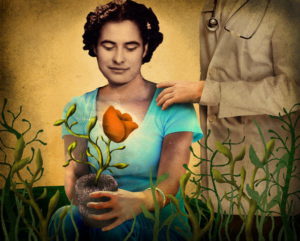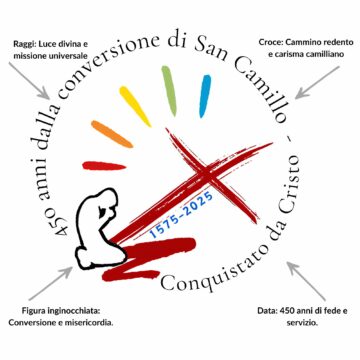 The term ‘palliative’ has its origins in the Latin word ‘pallium’ (cloak), an article of clothing used on cold days to protect a person against the harshness of the weather. For this reason, forms of palliative care are ‘enveloping’, global, holistic; they are not – as we are sometimes led to believe – a question of ‘façade’, inefficient, and – almost – a placebo. Palliative care, in fact, has a scientific character and rightly forms a part of the services of public health, supplementing activities involving prevention, active treatment and rehabilitation, through the alleviation of pain and suffering.
The term ‘palliative’ has its origins in the Latin word ‘pallium’ (cloak), an article of clothing used on cold days to protect a person against the harshness of the weather. For this reason, forms of palliative care are ‘enveloping’, global, holistic; they are not – as we are sometimes led to believe – a question of ‘façade’, inefficient, and – almost – a placebo. Palliative care, in fact, has a scientific character and rightly forms a part of the services of public health, supplementing activities involving prevention, active treatment and rehabilitation, through the alleviation of pain and suffering.
Palliative care began in a formal way with Dr. Cicely Saunders (1918–2005), an English nurse and medical doctor who practised her profession by accompanying patients during the terminal stages of their lives. Her nearness to sick people, which came from her profession as a nurse, and her clinical knowledge, which was the outcome of her medical experience, led her to develop the theory of palliative care as a therapeutic approach where the active treatment of illness ceases to have any meaning and any prospects of achieving a cure. Saunders saw in the hospice a place suited to the implementation of her theories and she contributed to their birth with the opening of the St. Christopher Hospice in London. Since then, palliative care has become a phenomenon in constant expansion in all latitudes of the world and in all cultural contexts, even though it has been slowed own – and this took place above all at the outset – by cultural and religious prejudices, by the resistance of medical science, and by the specific sociological conditions of some countries.
Palliative care is not the care that is provided during the stage that precedes death, whose inescapable sentence it thereby represents. Given the fact that it continues active care (‘continuum care’, to use the English phrase), it can begin at a stage well before the appearance of the symptoms that belong to the final phase of the illness. Indeed, as it constitutes a general taking of responsibility for a person and the alleviation of all the aspects of their suffering, it should be flanked by the active therapies that begin with the diagnosis of cancer and above all implemented during the continuation of treatment. In the year 2013, a very large group of Italian medical associations and societies agreed on a document relating to the application of palliative care in specific areas. To sum up its contents, the document identified the conditions that qualify a patient to receive palliative care; extended palliative care to patients with chronic-degenerative and incurable illnesses; and suggested an early palliative approach involving the simultaneous provision of palliative care and specialist treatment directed towards the reduction of the fundamental illness (once again we may employ the English phrase – ‘simultaneous care’).
 Palliative care is equidistant between euthanasia and exaggerated treatment. Through palliative care one overcomes the polarisation inherent in the temptation to end suffering that is considered ‘senseless’ or – in opposite fashion – to want at any cost to fight the illness so as to overcome it. Indeed, in palliative care the objective is no longer an illness to be diagnosed, monitored and treated, but a person to be taken care of, or, to put it better, to be assisted, to be ‘enveloped’ with attention (here we are helped by the distinction that is made in English between ‘active care’ and ‘taking care of’). To achieve this objective, palliative care adopts an approach based upon the proportionality and appropriateness of what is done, ‘planning specific and more suitable parallel clinical-care pathways…with the involvement of the patient and his or her family relatives’.[1]
Palliative care is equidistant between euthanasia and exaggerated treatment. Through palliative care one overcomes the polarisation inherent in the temptation to end suffering that is considered ‘senseless’ or – in opposite fashion – to want at any cost to fight the illness so as to overcome it. Indeed, in palliative care the objective is no longer an illness to be diagnosed, monitored and treated, but a person to be taken care of, or, to put it better, to be assisted, to be ‘enveloped’ with attention (here we are helped by the distinction that is made in English between ‘active care’ and ‘taking care of’). To achieve this objective, palliative care adopts an approach based upon the proportionality and appropriateness of what is done, ‘planning specific and more suitable parallel clinical-care pathways…with the involvement of the patient and his or her family relatives’.[1]
In palliative care, the traditional medical approach marks time. The patient, afflicted by the experience of illness and suffering, is placed at the centre of things and the approach shifts from the organ to the person, from the particular to the general. Individual biochemical facts, signs and symptoms matter inasmuch as they allow the general wellbeing of the person to be assured. For this reason, palliative care addresses, through tested therapeutic protocols, the control of symptoms. These influence the quality of life of the person to the point that often the patient would like to reduce this quality of life rather than endure the malaise of many symptoms that are oppressive and resistant to treatment. Science offers many resources for the treatment of symptoms and their appropriate and proportionate use can improve the quality of the time that remains to the patient. An approach that is technically suited to the treatment of symptoms requires constant updating, careful attention and observation, a detailed gathering of data and their analysis, a capacity for group work and the sharing of observations and experiences, and, lastly, nearness to the person in order to obtain his or her trust and esteem.
In palliative care, therefore, technical competence and a relationship walk hand in hand because they can assure that ‘more’ of meaning that never ceases to exist, even during the terminal stage of an incurable illness. Only in this way does palliative care contribute to its role of humanising medicine!
[1] Vedi, SIARTI, ‘Gravi insufficienze d’organo ‘end stage’’, ‘Premessa’.











